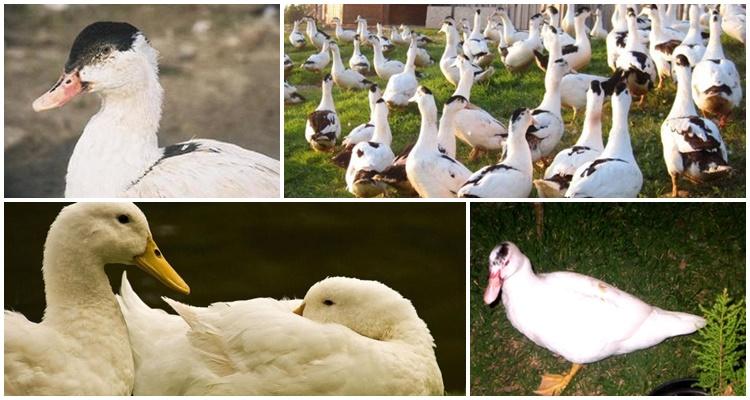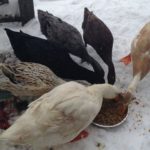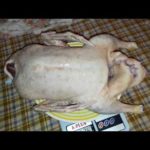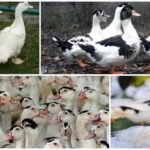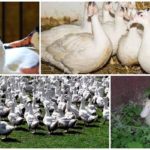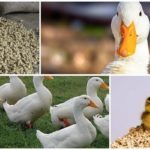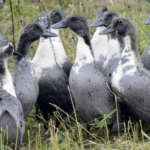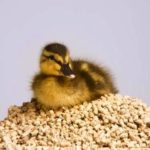Experienced and novice bird breeders agree that mulards are the calmest representatives of the duck family. The interspecific hybrid grows quickly, has lean, nutritious meat, and a large liver that can be used to prepare a delicacy. Since this variety of waterfowl was bred relatively recently, many owners are interested in the question: how long do mulardas grow before slaughter?
How long do mulardas grow?
Cross poultry - mulard - is the result of selection by French specialists.It is distinguished from other ducks by a black spot on its head, an elongated neck, and a dense body build. The color of the plumage is different - white, frilly or dark.
It is impossible to get offspring from them - the females are sterile. The main purpose of growing hybrids is lean, soft meat. With proper care and a properly structured diet, the chicks quickly gain weight. The first molt in mulards begins at the age of 65-70 days. If by this time the bird is ready for slaughter, and the breeder does not intend to keep it longer (to obtain liver for foie gras, cross ducks need to be raised for up to 4 months), the owner proceeds to slaughter the flock.
What can affect the timing?
Factors influencing slow growth of ducks:
- Keeping different types of waterfowl in one pen. Geese are slightly larger than ducks and may not allow them to approach the feeder. When malnourished, mulardas grow slowly.
- Unbalanced diet. Most often, the breeder feeds the poultry for his own consumption with grain mixtures, adding boiled vegetables, succulent feed, and sand to them. Mulards gain weight more slowly, but the taste of the meat is much more natural.
In order for a duck to grow quickly, it must receive vitamins and calcium from its food. All necessary microelements are present in the feed.
At what age should ducks be killed?
The most accurate method for determining whether a duck is ready for slaughter is to be guided by the condition of the plumage. Mulards begin to be cut down already at 2 months of age. It is in the time period of 60-65 days that they are completely covered with feathers, and the weight approaches 3.8-4 kg. These are the optimal parameters to kill the herd.
How to score a mulard?
Before cutting the mulards, you need to inspect the plumage of the bird. An important condition is that there are no stumps on it. Otherwise, the carcass will be “prickly”, unattractive, and plucking will take a lot of time.
Before slaughter, the ducks are prepared: 12-16 hours in advance, so that any remaining food leaves the stomach and crop, they stop feeding them. At first, the birds are not limited to water, but the drinking bowls are removed 6-7 hours before slaughter. In the barn where the mulards are kept at night, the lighting is left on.
At home, it is better for beginners to use proven methods:
- Decapitate the carcass. Take the bird by the head, stretch its neck, and cut the carotid artery with a knife. In this case, the knife blade should be tilted slightly downwards. Another way is to take the duck by the wings, place its head on a block, and chop it off with an ax.
- Hang the duck by its legs with its wings behind its back. Leave in this state for 5-10 minutes until the blood drains completely.
The next step is to pluck the carcass. There are 2 ways:
- dry processing. To avoid damaging the carcass, feathers are carefully plucked, placing the bird comfortably on a flat surface or hanging it upside down. Start from the sternum and turn over onto your back. The final phase is plucking the wings and tail;
- scalding. The water is heated to 80˚C (dipping a slaughtered duck into boiling water is incorrect - the skin will burst and plucking the carcass will not be easy). After dipping the carcass in a container of hot water for a few minutes, give it some time to cool. Otherwise, not only the bird’s skin, but also the breeder’s hands will suffer from the high temperature. Then they begin to remove the feathers - first of all, they pluck the cover from the wings and tail.After this, they move on to the neck and chest, removing the feathers from the back and legs is the last stage.
After plucking the feathers, the duck down is scorched using a gas burner. Manipulations are carried out carefully, making sure that the fat under the skin does not begin to melt. Otherwise, the skin will burst and the carcass will lose its presentation. They begin cutting up the bird, removing the crop, esophagus and giblets.
If there is abdominal fat, this is also removed. Be sure to cut out the sebaceous gland on the tail (if it is not removed, it will significantly spoil the taste of the cooked meat).
Then the mularda is washed under running water. There is no need to keep the bird under the stream for a long time so as not to wash out the nutrients. If the carcass is to be frozen, it must be allowed to dry.
Having disassembled the bird into its components, the meat parts are used for stewing, and the bones are used to prepare broths. Abdominal fat and skin are melted, the fat can be sealed in jars.

